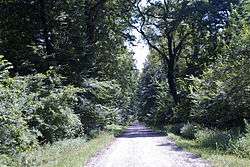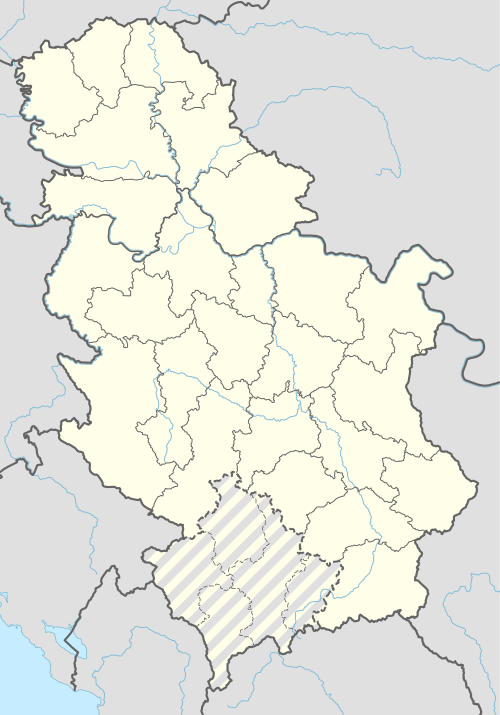Progar
Progar (Serbian Cyrillic: Прогар) is a suburban neighborhood of Belgrade, the capital of Serbia. It is located in Belgrade's municipality of Surčin.
Progar | |
|---|---|
 Bojčinska Šuma | |
 Progar | |
| Coordinates: 44°43′N 20°10′E | |
| Country | |
| Area | |
| • Total | 39.25 km2 (15.15 sq mi) |
| Population (2011) | |
| • Total | 1,445 |
| • Density | 37/km2 (95/sq mi) |
| Time zone | UTC+1 (CET) |
| • Summer (DST) | UTC+2 (CEST) |
Location
Progar is located in Syrmia (sub-region of Podlužje), in southwestern corner of the municipality (Bojčinska šuma) and stretches from the left bank of the Sava (the mouth of the Jarčina canal) to the southern shores of the Živača pond, 20 kilometers southwest of Surčin, its municipal seat. Local roads connect Progar with the villages of Kupinovo and Boljevci.
Demographics
Progar is statistically classified as a rural settlement (village). Because of the distance from Belgrade and slow economic development, it is one of the rare settlements in the municipality that doesn't have significant growth of population: 1,457 (1991 census) and 1,455 (2002 census; consisting of Serbs 1,381 (94,91%), Yugoslavs 9 (0,61%) Hungarians 8 (0,54%) and Croats 8 (0,54%).
Characteristics
The remains belonging to the Scordisci, a Celtic tribe which founded Singidunum and Taurunum, the predecessors of Belgrade and Zemun, respectively, were found in Progar.[2]
Despite possibilities (forest area of Bojčinska šuma, Živača pond and the neighboring fish pond, river island of Progarska ada on the Sava) for tourism, Progar is still almost exclusively agricultural settlement. There is a small beach on the ada, "Tarzan plaza" (Tarzan beach).[3] The beach is 40 km (25 mi) southwest from downtown Belgrade. The beach has no facilities except for the small kafana. It got its name because of the vines hanging above the beach, often used by the swimmers to jump into the water, in the Tarzan style.[4]
Summer festival "Bojčinsko kulturno leto" (Bojčin cultural summer) is held in the Bojčinska šuma. Every weekend, poets, musicians, dancers and theatrical troops perform on an open stage in the woods.[3] In 2011 a permanent exhibition of the sculptures donated by the artists from Serbia, Bulgaria and Macedonia was set in the forest.[5]
Bojčin Forest, located in the southeastern section of Syrmia, in the Sava valley, is the remnant of the once vast and thick pedunculate oak marshy forests. There are 185 plant species in the forest, of which 15 are under protection or strict protection, and 165 species of fungi (15 protected). There are 10 species of amphibians and reptiles, of which 8 are protected. One third of the entire number of the bird species found in Serbia, 108, can be found in Bojčin.[6]
References
- "Насеља општине Сурчин" (pdf). stat.gov.rs (in Serbian). Statistical Office of Serbia. Retrieved 22 October 2019.
- Ana Vuković (8 November 2018). "Tragom Skordiska u našem gradu" [Trails of the Scordisci in our city]. Politika (in Serbian). p. 15.
- Dimitrije Bukvić (14 April 2013). "Ruralni Beograd - dve trećine prestonice" (in Serbian). Politika.
- Branka Vasiljević (18 July 2010). "Stidljive drugarice Savskog jezera" (in Serbian). Politika.
- "Bojčinska šuma", Politika (in Serbian), 31 July 2011
- Vladimir Vukasović (9 June 2013), "Prestonica dobija još devet prirodnih dobara", Politika (in Serbian)
Sources
- Beograd - plan grada; M@gic M@p, 2006; ISBN 86-83501-53-1
| Wikimedia Commons has media related to Progar. |